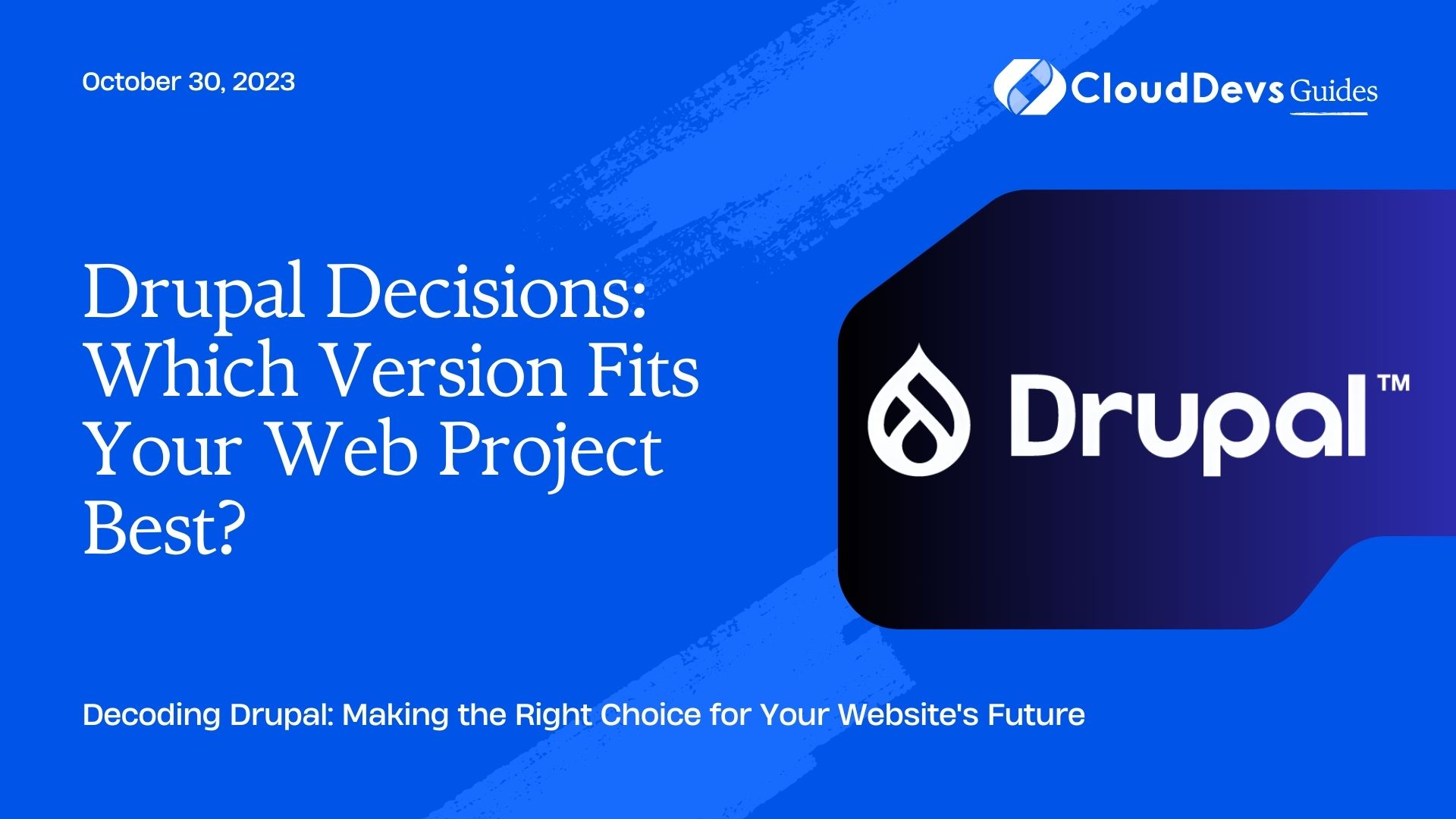Drupal Decisions: Which Version Fits Your Web Project Best?
Drupal, a popular content management system (CMS), has undergone significant changes and improvements over the years. If you’re planning to build or update a website using Drupal, you might be wondering which version to choose. Drupal 7, Drupal 8, and Drupal 9 are the three major releases that have shaped the Drupal ecosystem. In this blog post, we’ll compare these versions to help you make an informed decision.
Drupal 7: The Reliable Workhorse
Drupal 7, released in January 2011, has been a reliable choice for many years. It has a large and mature ecosystem with a vast library of modules and themes developed by the Drupal community. Some key features of Drupal 7 include:
1. Stability
Drupal 7 is known for its stability. It has received numerous updates and security patches over the years, making it a secure choice for websites that require long-term support.
2. Mature Modules
The Drupal 7 ecosystem boasts thousands of contributed modules, allowing you to extend the functionality of your website with ease. Many popular modules, such as Views and Webform, originated in Drupal 7.
3. Large User Community
With a vast user community, you can find plenty of resources, documentation, and support for Drupal 7. This makes it accessible even for those new to Drupal.
4. Cost-Effective Maintenance
Drupal 7 has been around for a while, which means there is a wealth of knowledge available to maintain and troubleshoot websites built on this version. This can result in cost savings for businesses.
Drupal 7 also has some downsides:
1. Outdated Technology
Drupal 7 uses older technology and lacks some of the modern features found in newer versions. It may not be the best choice for websites that require cutting-edge functionality.
2. End of Life
Drupal 7 reached its end of life on November 28, 2022. While community support may continue for some time, it won’t receive official updates or security patches, making it less secure in the long run.
Drupal 8: The Game-Changer
Drupal 8, released in November 2015, brought about significant changes to the Drupal landscape. It introduced a more modern architecture and incorporated Symfony components, making it a powerful and flexible CMS. Key features of Drupal 8 include:
1. Symfony Integration
Drupal 8’s use of Symfony components improved its coding standards and made it more developer-friendly. This integration made Drupal more accessible to a wider audience.
2. Mobile Responsiveness
Drupal 8 embraced mobile responsiveness from the ground up, ensuring that websites built on this version would work seamlessly on various devices and screen sizes.
3. Enhanced Theming
The introduction of the Twig templating engine in Drupal 8 simplified theming and made it easier for developers to create custom themes for their websites.
4. Easy Content Management
Drupal 8 offered a more intuitive content management experience with an in-place editing feature that allowed users to edit content directly on the page.
Drupal 8 also had some challenges:
1. Migration Complexity
Migrating from Drupal 7 to Drupal 8 was a complex task due to the architectural differences between the two versions. This could be a barrier for some organizations.
2. Learning Curve
While Drupal 8 was more developer-friendly, it also had a steeper learning curve for those accustomed to Drupal 7.
Drupal 9: The Evolutionary Step
Drupal 9, released in June 2020, is not a revolutionary change like Drupal 8 but rather an evolution of it. It was designed to be backward-compatible with Drupal 8, making the transition smoother for users. Key features of Drupal 9 include:
1. Built on Drupal 8
Drupal 9 shares most of its codebase with Drupal 8, making it easier to upgrade from Drupal 8 to Drupal 9. This ensures a more straightforward transition for existing Drupal 8 users.
2. Improved Performance
Drupal 9 comes with performance improvements and updated libraries, ensuring that your website runs faster and more efficiently.
3. Enhanced Security
As with any new release, Drupal 9 benefits from updated security features and support. Staying up to date with the latest version is crucial for maintaining a secure website.
4. Long-Term Support
Drupal 9 offers long-term support (LTS) until November 2023, providing a secure and stable platform for websites. After that, Drupal 10 will take over, following a similar pattern of backward compatibility.
There are some considerations with Drupal 9:
1. Module Compatibility
Not all contributed modules from Drupal 7 and Drupal 8 are available for Drupal 9. You’ll need to check module compatibility before upgrading.
2. Upgrade Effort
While upgrading from Drupal 8 to Drupal 9 is less challenging than the Drupal 7 to Drupal 8 transition, it still requires effort and testing.
Which Version Should You Choose?
The choice between Drupal 7, Drupal 8, and Drupal 9 depends on your specific needs and circumstances. Here are some scenarios to consider:
1. If You’re Starting from Scratch
If you’re building a new website from scratch and want the latest features and long-term support, Drupal 9 is the clear choice. It provides a modern platform with ongoing security updates.
2. If You’re on Drupal 7
If you’re currently on Drupal 7, you should consider upgrading to Drupal 9 to ensure security and support. While the upgrade may require some effort, it’s a necessary step as Drupal 7 is no longer officially supported.
3. If You’re on Drupal 8
If you’re already on Drupal 8, transitioning to Drupal 9 is a logical step. The upgrade process is more manageable, and you can continue to benefit from the latest features and support.
4. If You Have Complex Customizations
If your website has complex customizations and many contributed modules that are not available for Drupal 9, you may need to assess the feasibility of upgrading or consider a more gradual transition.
5. If You Have Budget Constraints
If you have budget constraints and can’t immediately invest in a full upgrade, consider starting with Drupal 8 and planning your transition to Drupal 9 when resources become available.
Conclusion
choosing the right Drupal version depends on your specific requirements, existing infrastructure, and budget. While Drupal 7 has served as a reliable workhorse for many years, it’s essential to transition to Drupal 9 or newer versions to ensure security and long-term support. Drupal 8 and Drupal 9 offer modern features, making them attractive options for new projects and existing Drupal users.
Ultimately, the key to a successful Drupal project lies in proper planning, evaluation of your needs, and staying informed about Drupal’s evolving ecosystem. Whichever version you choose, the Drupal community’s dedication to innovation and support ensures that you’ll have a robust platform for building and maintaining your website.
Table of Contents







